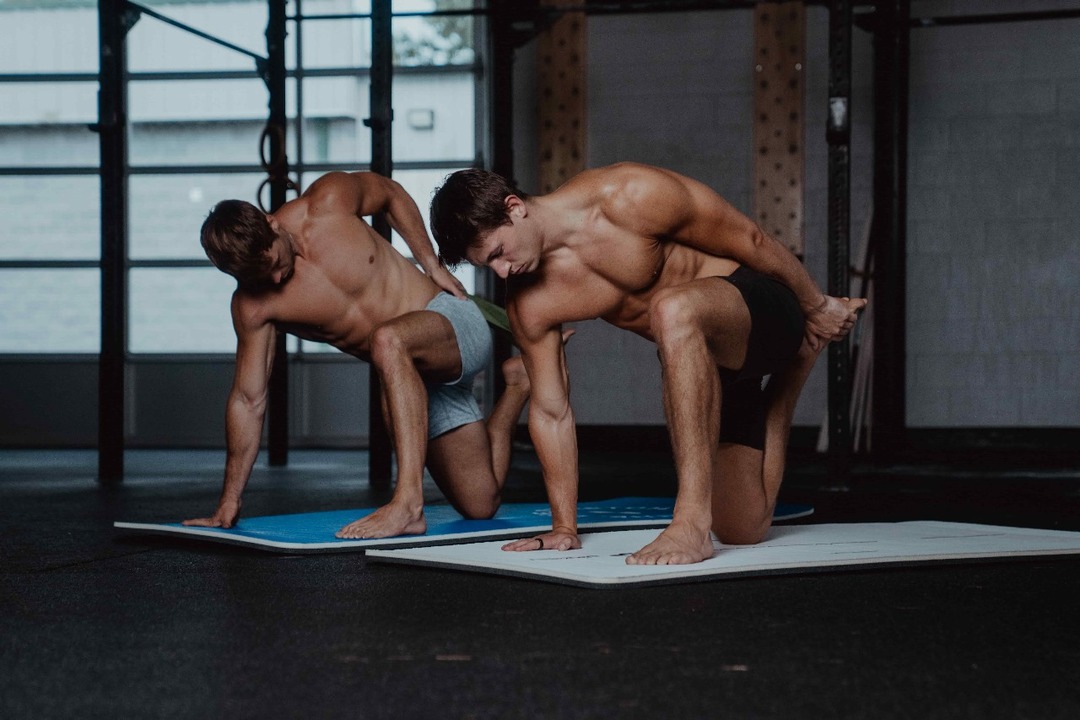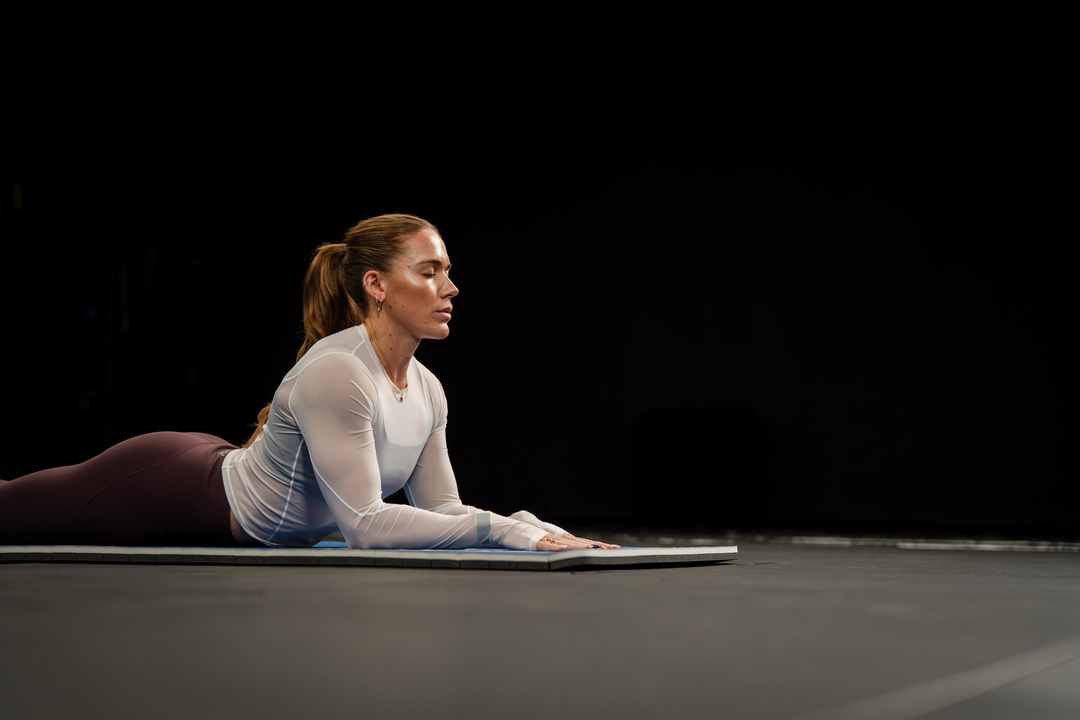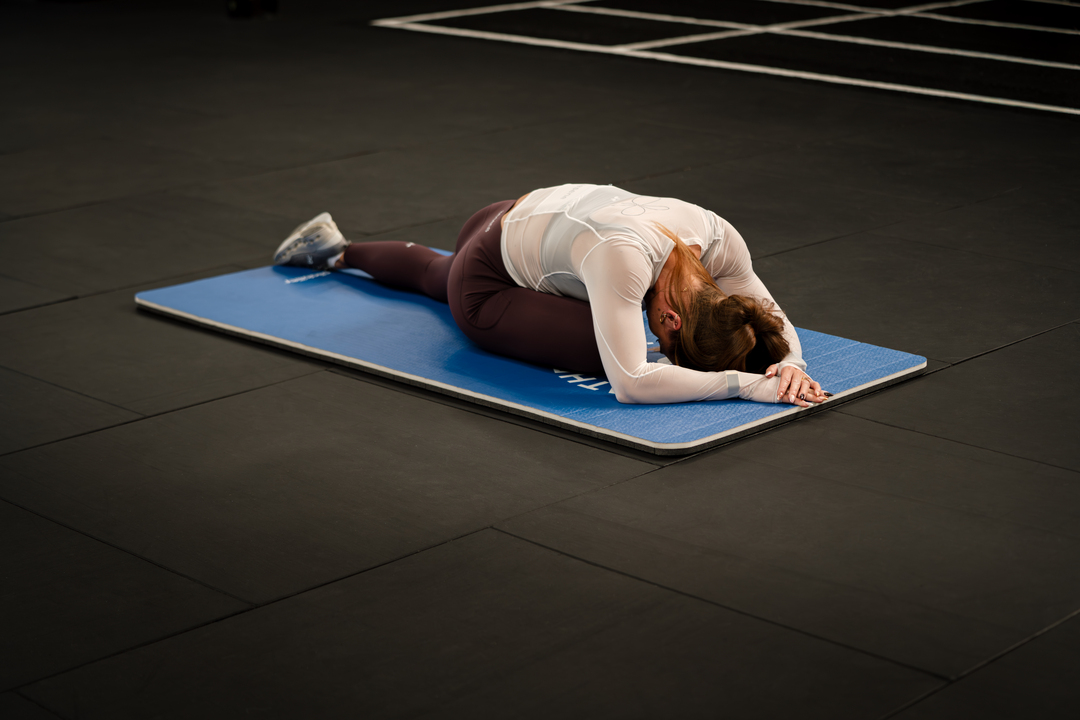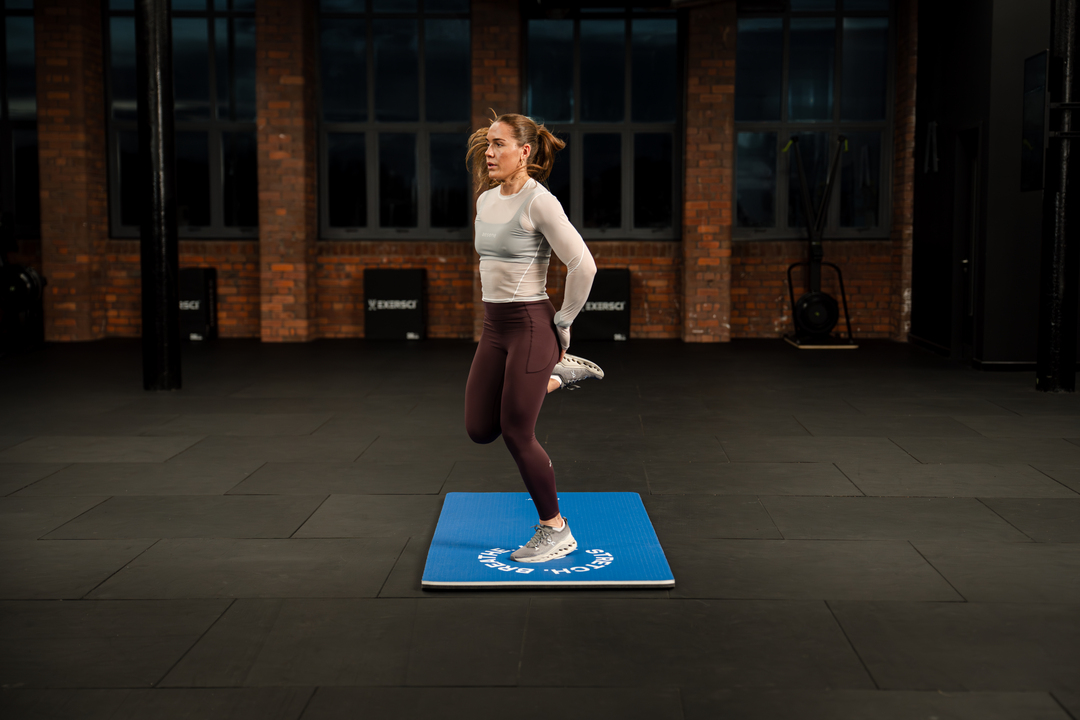Wrist mobility is an often overlooked aspect of mobility training. However, stiff and painful wrists can limit your performance in many activities, like lifting weights, rock climbing, and even typing. The good news is that with some focused work, you can restore your wrist function and improve your performance in any activity that involves even a bit of grip strength.
This blog will outline the benefits of wrist mobility exercises and how Pliability’s mobility app can help with such exercises. It will also provide a list of targeted exercises to help you achieve your goals. Consistent practice can restore your wrist function and keep your wrists healthy for optimal performance.
What Are Wrist Exercises?

Wrist exercises are targeted movements designed to strengthen the muscles, tendons, and ligaments around the wrist. These exercises aim to improve flexibility, mobility, and strength, helping prevent injury and alleviate pain caused by strain or overuse.
Elbow & Wrist Health
For many people, working at a computer or typing on a tablet or phone is how we spend most of our day. This can lead to several biomechanical issues or ailments, including:
- Wrist inflammation
- Potential carpal tunnel syndrome
In addition to setting up an ergonomically effective working environment and putting down the iPad at dinner time, it’s important to include some elbow and wrist mobility in one’s daily routine to help ward off the numbness and tingling that are precursors to much more severe disorders.
Hand & Wrist Weakness
Your hands and wrists can become weak due to:
- Age: Grip strength naturally declines as you get older.
- Disuse: Your grip strength will decrease if you don’t use your hands and wrists regularly.
- Overuse: Repeated actions with your hands and wrists can lead to inflammation, pain, and weakness.
Medical conditions like cubital or carpal tunnel syndrome, hand arthritis, diabetes, stroke, multiple sclerosis, ALS (Lou Gehrig’s disease), tendonitis, or injuries.Medications with side effects that weaken the hands and wrists.
Wrist & Shoulder Connection
Because the wrists are distal (far away) from the body's core, this joint, much like the ankle and the feet, can be affected by the joints that stem from the trunk—in this case, the shoulders. So, it’s important to remember the importance of the shoulders when thinking about how the wrists and the rest of the arm function.
Wrist exercises help build strength in the muscles surrounding your wrists, supporting a full range of motion. Strong wrists are essential for avoiding repetitive motion injuries such as carpal tunnel syndrome.
Who Needs Wrist Exercises?
Wrist Exercises Are Recommended After:
- Wrist surgery
- Elbow surgery
- Shoulder surgery
- Stroke
- Carpal tunnel syndrome
- Fractures of the wrist bone, humerus (large bone in the arm), or the small knuckles
Wrist Flexibility & Strength
Stretching and exercising the muscles around your wrists will keep the wrists flexible and robust and help you avoid repetitive motion and stress injuries. If you’ve had an injury, these stretches and exercises can help you recover your wrist range of motion.
Why Are Wrist Exercises Beneficial?
Both stretching and exercising increase the production of synovial fluid, which lubricates your wrist joints and helps improve their function.
How Your Stiff, Weak Wrists Are Holding You Back
.jpeg)
Stiff or weak wrists can limit both everyday activities and gym performance. Your wrists are involved in almost any task, whether you are typing, doing push-ups, or lifting weights.
So, it’s no surprise that any pain or discomfort in this area can severely impact your quality of life and workout performance, especially in exercises like lifting, push-ups, and yoga poses that require:
- Wrist stability
- Strength
Wrist Health & Mobility
Ignoring wrist issues can lead to chronic problems, making it even more important to address them as soon as possible. Wrist mobility exercises can improve overall functionality and help you regain strength and flexibility for pain-free movement.
Wrist Injuries Respond Well to Conditioning
Several conditions can cause wrist pain, including:
- Strains
- Sprains
- Tendonitis
- Bursitis
- TFCC tears
- Stress fractures
The good news is that many of these issues can be improved with proper wrist conditioning.
Wrist Conditioning Requires Flexibility
Wrist conditioning work begins with flexibility. First, you must ensure adequate wrist flexibility to perform your training safely. For most training that loads your wrists, you want to be able to flex and extend your wrists to at least 90-degree angles without a lot of force.
If your wrists can’t flex and extend properly, loading them with your body weight (or more) through training is like finding a stuck hinge and, instead of loosening it properly, just pushing harder and harder until something gives.
Strength and Endurance Matter, Too
Wrist strength and endurance are also needed to perform bodyweight exercises, especially hand balancing.
While the standard recommendation for building wrist conditioning is to spend as much time on your hands as possible, you must work up to it, especially if your wrists already hurt.
Modify Movements if Needed
If these exercises are too uncomfortable for me, don’t worry about it. You just have to adjust to your level. A good option is to exercise on a table or other elevated surface to take some of the pressure off. And if even that is too uncomfortable, feel free to do them on a wall.
The important thing is to move within the range you can and not to move into pain. Stop short of where you feel pain and work on the range you’ve got. Over time, that range will increase, and you’ll be doing more and feeling better.
Animal Movements Increase Wrist Robustness
You can also make your wrists robust using animal movements. Once you have the strength and mobility in your wrists to support your body weight, we recommend getting familiar with animal movements, specifically the:
- Bear
- Monkey
- Frogger
Pliability Mobility App
Pliability offers a fresh take on yoga tailored for performance-oriented individuals and athletes. Our app features a vast library of high-quality videos designed to:
- Improve flexibility
- Aid recovery
- Reduce pain
- Enhance range of motion
Pliability provides daily-updated custom mobility programs for those interested in optimizing their health and fitness. It also includes a unique body-scanning feature to pinpoint mobility issues. If you're feeling limited by pain oryour ability to move, Pliability aims to:
- Complement your existing fitness routine
- Help you move better
Free Trial Offer
Sign up today for 7 days absolutely for free on iPhone, iPad, Android, or our website to improve flexibility, aid recovery, reduce pain, and enhance range of motion with our mobility app.
Related Reading
- Ankle Mobility Exercises
- Knee Mobility Exercises
- Shoulder Mobility Exercises
- Hip Mobility Exercises
- Thoracic Mobility Exercises
- How To Improve Flexibility
- Stretch Before Or After Workout
- Leg Mobility Exercises
- Best Stretching Routine
- Mobility Exercises For Beginners
- Mobility Exercises For Athlete
- Lower Body Mobility Exercises
- Back Mobility Exercises
9 Benefits of Doing Wrist Exercises

1. Boost Your Strength and Endurance with Wrist Exercises
Wrist curls target the muscles in your forearms, including the flexors and extensors. These muscles are responsible for wrist and hand movement and play a vital role in gripping and lifting objects.
Wrist curls can help build strength and endurance in these muscles, allowing you to perform everyday activities more quickly and efficiently.
2. Improve Your Grip Strength
Strong wrists are essential for a strong grip, which is necessary for many activities, including:
- Weightlifting
- Rock climbing
- Sports like tennis and golf
Wrist curls can help increase your grip strength by strengthening the muscles in your hands and forearms. A strong grip can also help prevent injuries, such as:
- Sprains
- Strains
3. Reduce Your Risk of Injuries
Weak wrists can increase the risk of injuries, particularly in repetitive movements or heavy lifting activities. Wrist curls can help build the muscles around the wrist joint, making it:
- More stable
- Less susceptible to injuries
Wrist Strength & Form
Strong and mobile wrists can also improve your form and technique in exercises like:
- The bench press
- Overhead press
- Deadlift, reducing the risk of injuries
4. Improve Your Flexibility and Range of Motion
Wrist curls involve a full range of motion, which can help improve wrist flexibility and range of motion. Improved flexibility can also prevent wrist stiffness and pain, which can occur due to prolonged sitting or repetitive movements.
5. Boost Blood Flow with Wrist Exercises
Wrist curls can help increase blood flow to the muscles in the forearms and hands, promoting faster recovery and reducing the risk of muscle soreness.
Improved blood flow can also help prevent conditions like carpal tunnel syndrome, caused by wrist compression of the median nerve.
6. Enhance Your Posture
Strong and mobile wrists can also improve your posture, as they help maintain proper alignment of the:
- Wrist
- Hand
- Forearm
Good posture can help reduce tension in the upper body and prevent injuries, such as shoulder impingement syndrome.
7. Increase Muscle Tone in Your Forearms
Wrist curls can also help increase muscle tone in the forearms, giving them a more defined appearance. Increased muscle tone can also improve your overall aesthetics and confidence.
8. Improve Your Coordination and Dexterity
Wrist curls can help improve your coordination and agility, which are important for activities that require fine motor skills, such as:
- Playing a musical instrument
- Typing on a keyboard
Improved coordination and agility can also prevent injuries, such as:
- Strains
- Sprains
9. Enhance Your Sports Performance
Strong and mobile wrists can enhance your sports performance by improving your grip strength, stability, and control. This can help you perform better in tennis, golf, and basketball, where a strong grip and wrist control are essential for success.
Related Reading
- Golf Mobility Exercises
- Upper Body Mobility Exercises
- Mobility Exercises For Runners
- Can You Over Stretch
- Squat Mobility Exercises
- Functional Mobility Exercises
- Why Stretching Is Important
- Foot Mobility Exercises
- Arm Mobility Exercises
- Hamstring Mobility Exercises
- Elbow Mobility Exercises
- Rotator Cuff Mobility Exercises
- Bed Mobility Exercises
- What Are Mobility Exercises
- Full Body Mobility Exercises
28 Wrist Mobility Exercises for Pain-Free Hands & Wrists
.jpeg)
You’ll find stretches and strengthening exercises that target both the wrists and hands. These may help improve flexibility and strength, reduce pain, and promote recovery.
1. Finger Stretch
This simple motion can help stretch your wrist and fingers. It’s good to do this as a warm-up before more strenuous exercises.
- Sit comfortably with your elbow bent and your arm at a right angle.
- Make a fist.
- Slowly open your hand, spreading and stretching your fingers.
- Do several repetitions.
- Repeat with the other hand.
You can also use this stretch periodically during repetitive activities like typing.
2. Wrist Extension With Dumbbell
You’ll need a dumbbell, a chair, and a table or desk for the wrist extension.
- Sit in the chair with your forearm resting on a table.
- Hold a 2- or 3-pound dumbbell and hang your wrist and hand over the table's edge.
- With your palm facing down, slowly lift your hand so the back of your hand moves towards the ceiling.
- Your forearm should remain on the table.
- Once your wrist is fully extended, hold the position for a few seconds, then slowly lower your hand down.
- Repeat this motion 10 to 15 times.
- Perform two to three sets.
3. Dumbbell Wrist Flexion
- Continue holding the weight and resting your forearm on the table.
- Turn your hand over, so your palm is facing the ceiling.
- Keep the back of your arm against the table.
- Flex your wrist up so that your palm moves towards the ceiling.
- Once your wrist is fully flexed, hold the position for two to three seconds.
- Then, slowly lower your hand back to the starting position.
- Repeat the wrist flexion exercise for two to three sets of 10–15 repetitions.
This exercise can also be done without the dumbbell.
4. Prayer Stretch
- Stand with your elbows bent and press your palms together, fingertips up, just below your chin (as if you’re praying).
- Keep your fingers together, and lower them until you feel a stretch along the insides of your arms.
- Allow your palms to separate but keep your fingers together.
- Hold for 30 seconds.
- Do two to four repetitions.
5. Steeple Stretch
- For this stretch, start in the prayer position from above.
- Splay your fingers and thumbs as wide as you can comfortably.
- Keeping your fingers together, separate your palms and bring them back together.
- Do several repetitions a few times per day.
6. Wrist Supination With Dumbbell
What Is Supination? Wrist supination is turning your wrist over, so your palm is face-up. This motion is performed by the biceps muscle in your upper arm and smaller muscles in the forearm.
- Sit in a chair with the side of your forearm resting on the table and your wrist and hand hanging over the edge.
- Your thumb should face the ceiling.
- Hold the end of a small, 1- to 3-pound dumbbell like a hammer.
- Slowly allow your hand and wrist to rotate so your palm faces up toward the ceiling.
- Hold the end position for a few seconds, then slowly rotate your hand back up, so the dumbbell is straight up again.
- You can combine the supination exercise with the pronation exercise explained in the next step, alternating which way I rotate my wrist.
7. Wrist Pronation With Dumbbell
Wrist pronation refers to the position of your hand facing down as if you were pouring a pitcher of water.
To strengthen your wrist pronators, sit in a chair with your forearm supported on a table and your wrist and hand over the edge.
- Hold one end of a dumbbell with the weight pointing up towards the ceiling.
- Slowly rotate your hand, so your wrist and palm face down towards the floor.
- Hold this position for a few seconds, then slowly turn your hand back to the starting position with the weight pointing up towards the ceiling.
- Perform two to three sets of 10 to 15 repetitions.
- If you combine this exercise with wrist supination (in the previous step), alternate turning your palm up with turning my palm down.
8. Ball Squeeze Strengthener
You can do this exercise with any ball, about the size of a tennis ball. Or you can use exercise putty, which comes in soft, medium, and hard strengths.
Sit comfortably and take the ball or putty in your hand, wrapping your fingers and thumb around it.
- Squeeze as hard as you can.
- Hold the squeeze for 3 to 5 seconds.
- Relax your grip slowly.
- Repeat 5 to 10 times.
9. Rubber Band Strengthener
This exercise is simple, but it works the smaller hand muscles. You can also do it sitting at a desk or anywhere else.
- Take an ordinary rubber band and stretch it around the tops of your fingers and thumb.
- Slowly open your hand to stretch against the rubber band, and then slowly close your hand.
- Keep the motion controlled.
- Repeat 5 to 10 times.
10. Wrist Curls
This strengthening exercise can be done with a clenched fist or 1 to 5-pound weights. Depending on your physical strength, you can do both arms simultaneously or one arm at a time. You can also use a small food can or water bottle as a weight.
- Sit comfortably with your arm resting over your knees.
- Hold a weight with your palms facing down and your wrist hanging over the knee.
- Move your hand up as far as possible and then down as far as possible in a slow and controlled motion.
- Do a set of 10, then repeat.
- Repeat the exercise, but with your palms facing up.
- Increase your weight once you can easily do two or three sets.
- You can also do wrist curls with your arm in the air.
11. Wrist Walking
- Stand near a wall with your arms straight, your palms against the wall, and your fingers pointed up.
- Keep your palms against the wall, and walk your wrists down the wall as far as you can.
- Turn your hands around so that your fingers are pointed down.
- With your palms against the wall, walk your wrists back up as far as possible.
12. Raised Fist Stretch
To do this stretch:
- Start with your arm up beside your head, with your hand open.
- Make a fist, keeping your thumb outside of it.
- Slide your fingers toward your wrist until you feel a stretch.
13. Hooked Stretch
To do this stretch:
- Hook one elbow under the other and pull both arms towards the center of the torso. You should feel a stretch in your shoulders.
- Wrap one arm around the other so that the palms are touching.
- Hold the position for 25 seconds.
- Switch arms and repeat it on the other side.
14. Finger Stretch
To do this stretch:
- Bring the pinky and ring fingers together.
- Separate the middle and index fingers from the ring finger.
- Repeat the stretch 10 times.
15. Fist-Opener
To do this stretch:
- Make a fist and hold it in front of you.
- Stretch your fingers until your hand is flat and open, with the fingers together.
- Repeat the movements 10 times.
16. Windshield Wiper Wrist Movement
To do this stretch:
- Start with your hand face down on a table.
- Gently, point the hand to one side as far as it can go without moving the wrist.
- Hold it there for 3–5 seconds.
- Do the same on the other side.
- Repeat the movement three times on each side.
17. Thumb Pull
To do this stretch:
- Grab your thumb with the other hand.
- Gently pull the thumb backward, away from the hand.
- Hold the stretch for 25 seconds.
- Repeat it on the other thumb.
18. Alternate Finger Stretch
To do this stretch:
- Bring the middle and ring fingers together.
- Separate the pinky and index fingers from them.
- Repeat the stretch 10 times.
19. Backward Facing Wrist Stretch
- Place your hands out in front of you, rotating your wrists so that your fingers face your knees.
- Start with your fingers closer to your knees (this is easier than further away).
- Keeping your palms flat on the ground, shift your body back toward your heels and your hands.
- Do 5 repetitions.
- Hold for 5-10 seconds on the 5th rep, and repeat for one more round.
20. Palm Heel Up Side-To-Side Stretch
- Ensure your hands are flat on the ground with your fingers spread out.
- Lift the heel of your hands up off the ground.
- Push your hands into the ground while focusing on the knuckles, and go side to side.
- If this position is challenging, bring your hands closer to your body.
- Do this for about 15 seconds, going side to side.
21. Wrist Shakes
Simply shake your wrists out for 10-15 seconds (just like Andre 3000 eloquently said in Hey Ya).
22. Palm Pulses
- Put your hands flat on the ground, splaying your fingers as wide as possible.
- Pull your palms off the ground, keeping the top part of your hand and your fingers pressed into the ground.
- Pulse in and out of this position 10-30 times.
23. Back of the Hand Wrist Extension
- Start with my knuckles on the floor with your arms straight.
- Adjust your weight by sitting back or leaning forward.
- Open your palms, and roll the back of your hands flat on the ground.
- Do 2 sets of 8-10 reps.
24. Seal Walk
- Start with your palms on the ground, with your fingers facing your knees.
- Shoulders over your hands.
- Walk forward, crawling on your hands and knees to keep your chest up.
- Do 2 sets of 10-12 reps per hand.
25. Rear Facing Wrist Holds
- Start with the back of your hands on the floor, fingers pointing toward your knees.
- Hold the position for 3-10 seconds and aim to work toward a full 30-second hold.
26. “C” and “O” Exercises
- Starting with a straightened hand, pretend you are catching a ball by making a “C” or “O” shape with your fingers, going as far as possible.
- Straighten your fingers and repeat a few times on each hand to help with flexing issues.
27. Arm Roll-Ups
- Begin with arms extended in front and palms facing up.
- Flex the wrists to point the fingers upward.
- Bend the elbows and bring the fingertips to the shoulders.
- Tuck the fingers toward the biceps and point the elbows toward the sky.
This stretch should be felt from the shoulders to the fingers.
28. Wrist Windshield Wipers
With the elbows bent at 90 degrees at the sides, flex the wrist in various directions (holding light weights, if desired).
The Top 4 Wrist Mobility Exercises for the Gym

1. Plate Curls: Build Wrist Strength and Stability
One of my favorites for wrist mobility is plate curls. Since the plate is extended out, it will put extra stress on your wrist as you leverage it up, creating a great exercise.
Keep the plate firm, like it’s a full extension of your arm. Don’t accidentally collide the plate with your noggin!
2. Banded Wrist Stretches: Targeting Wrist Flexors and Extensors
The band should pull in the opposite direction of the stretch (fingers face one way, band pulls the other way). Shoot for 10-15 repetitions.
3. Wrist Curls and Reverse Wrist Curls: Strengthening Your Wrists for Better Performance
Hold your arm down with your other hand and let your wrist do all the lifting.
4. Barbell Levering: a Crazy Advanced Wrist Mobility Exercise
We’re getting into a crazy town with this one. It is an unbelievable wrist exercise that is not for beginners. Grab the bar with one hand, off-center, and lift it to parallel.
I recommend using a 15 lb/5 kg bar or lighter body pump bars. The leverage is crazy! You can also do this at a faster pace with a PVC pipe.
How to Work Out Safely and Avoid Injury

Consult with Your Doctor Before Starting Any Exercise Program
If you have a previous or pre-existing health condition, consult your physician before beginning an exercise program.
Proper exercise technique is essential to ensuring the safety and effectiveness of an exercise program. Still, depending on your needs, you may need to modify each exercise to attain optimal results.
Safe & Controlled
Always select a weight that gives you full body control throughout the movement. When performing any exercise, pay close attention to your body and stop immediately if you note pain or discomfort.
Warm Up & Cool Down
Incorporate proper warm-ups, rest, and nutrition into your exercise program to see continual progress and build body strength.
Your results will ultimately be based on your ability to recover adequately from your workouts. To allow sufficient recovery, rest for 24 to 48 hours before training the same muscle groups.
Related Reading
- Gowod Vs Pliability
- Tennis Mobility Exercises
- Weighted Mobility Exercises
- Cervical Mobility Exercises
- Resistance Band Mobility Exercises
- Rib Mobility Exercises
- Glute Mobility Exercises
- Best Yoga App
- Free Apps For Stretching And Flexibility
- Mobility Apps
- Stretching Apps
- Chest Mobility Exercises
- Glute Stretches
- Gluteus Medius Stretch
- Glute Stretch
- Cervical Radiculopathy Exercises
Improve Your Flexibility with Our Mobility App Today | Get 7 Days for Free on Any Platform
Pliability offers a fresh take on yoga, tailored for performance-oriented individuals and athletes. Our app features a vast library of high-quality videos designed to:
Pliability provides daily-updated custom mobility programs for those interested in optimizing their health and fitness. It also includes a unique body-scanning feature to pinpoint mobility issues. If you're feeling limited by pain or ability to move, Pliability aims to complement your fitness routine and help you move better.
Sign up today for 7 days absolutely for free on iPhone, iPad, Android, or our website to improve flexibility, aid recovery, reduce pain, and enhance range of motion with our mobility app.








